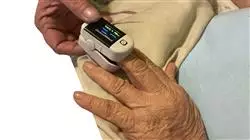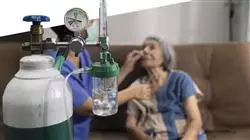University certificate
The world's largest faculty of medicine”
Description
Through this Professional master’s degree, 100% online, you will provide a comprehensive care focused on the needs of the patient and effectively address the most difficult symptoms"

As the world's population continues to age, the demand for Palliative Care focused on the specific needs of patients is on the rise. As such, medical care in this context plays a crucial role in improving the quality of life of users, as well as providing support to their families. However, despite advances in the treatment of symptoms associated with advanced chronic diseases, clinicians face significant challenges in the management of complex symptoms in terminally ill individuals. As such, physicians need to update their knowledge regularly to incorporate new treatments into their practice to help control symptoms and optimize patients' quality of life.
To facilitate this task, TECH has developed a complete program in Palliative Care. An academic itinerary that will delve into aspects ranging from pain treatments or symptom control, to emergency care during the end of life. It will also address the most innovative techniques to provide users with relief of suffering in all its dimensions (including thoracentesis, elastomeric infusors or drug delivery pumps). In this way, specialists will enhance their competencies to assess and manage a variety of symptoms in terminally ill patients.
The university program is taught in a 100% online format, which allows the experts to combine their update with the rest of their regular commitments. In addition, TECH employs its disruptive Relearning method with which doctors will progressively consolidate their knowledge without having to invest long hours of study. In turn, the program is supported by a teaching staff of excellence that is distinguished by having a renowned expert as International Guest Director. This scientist has accumulated dissimilar research results and is in charge of the development of 10 exhaustive Masterclasses.
This program guarantees you an exhaustive and exclusive update through the very complete Masterclasses of its International Guest Director"
This Professional master’s degree in Palliative Care contains the most complete and up-to-date scientific program on the market. Its most notable features are:
- Practical cases presented by experts in Palliative Care
- The graphic, schematic and eminently practical contents with which it is conceived gather scientific and practical information on those disciplines that are indispensable for professional practice
- Practical exercises where self-assessment can be used to improve learning.
- Its special emphasis on innovative methodologies
- Theoretical lessons, questions to the expert, debate forums on controversial topics, and individual reflection assignments
- Content that is accessible from any fixed or portable device with an Internet connection
You will deepen your understanding of Nutrition in Palliative Care Patients and be able to help them both maintain their energy and reduce fatigue"
The program’s teaching staff includes professionals from the sector who contribute their work experience to this specializing program, as well as renowned specialists from leading societies and prestigious universities.
The multimedia content, developed with the latest educational technology, will provide the professional with situated and contextual learning, i.e., a simulated environment that will provide immersive education programmed to learn in real situations.
This program is designed around Problem-Based Learning, whereby the professional must try to solve the different professional practice situations that arise during the course. For this purpose, students will be assisted by an innovative interactive video system created by renowned and experienced experts.
You will master the most sophisticated non-invasive techniques for pain control, such as Neuromodulators, Infiltrations or Plexus Ablations"

You will master the most sophisticated non-invasive techniques for pain control, such as Neuromodulators, Infiltrations or Plexus Ablations"
Syllabus
This program will provide physicians with a holistic approach to Palliative Care while developing advanced clinical skills. The syllabus will delve into issues ranging from oncology patient care or pain management to assisting family members in dealing with bereavement. In line with this, the syllabus will offer graduates the most advanced techniques oriented to terminal care, as well as innovative tools such as Ultrasound, Pleural Catheters or Endovenous Pumps. Therefore, specialists will manage a wide range of symptoms and provide personalized and comprehensive care to their patients.

A high level syllabus that analyzes the latest scientific postulates in fields such as Pediatric Palliative Care"
Module 1. Palliative Care
1.1. Current Situation in Palliative Care
1.1.1. Death in Modern Society
1.1.2. Evolution of the Specialty
1.1.3. Units at National and European Level
1.1.4. Units at International Level
1.2. Palliative Care from the Perspective of International Law
1.2.1. Human Rights
1.2.2. European Law
1.2.3. International Legality
1.3. Syllabuses
1.3.1. Accreditation
1.3.2. Pre-university Teaching
1.3.3. Post-university Teaching
1.4. Scientific Societies
1.4.1. National
1.4.2. Regional
1.4.3. Relations
1.5. Economic Perspective of Palliative Care in the Health Care System
1.5.1. Economic Impact on Palliative Illness Health Systems
1.5.2. Efficiency of Palliative Care Units
1.5.3. Impact on the Family Economy
1.6. Organization of Palliative Care
1.6.1. Hospital
1.6.2. Home Hospitalization Units
1.6.3. Palliative Care Based in Primary Care
1.7. Development of International Standards
1.7.1. Historical Evolution of Palliative Care
1.7.2. Birth of Modern Palliative Care
1.7.3. Development of Palliative Care Units
1.8. Research in Palliative Care
1.8.1. Evolution of Scientific Publications in Palliative Care
1.8.2. Impact Journals in Palliative Care
1.8.3. Latest Publications
1.9. Clinical History in Palliative Medicine
1.9.1. Clinical Evaluation of Symptoms
1.9.2. Scales in Palliative Medicine
1.9.3. Evaluation of the Family and Main Caregiver
Module 2. Palliative Care in Oncology Patients
2.1. Biology and Cancer Epidemiology
2.1.1. Epidemiology
2.1.2. Genetic and Environmental Factors
2.1.3. Evolution Over the Years
2.1.4. Chronification of Cancer
2.2. Medical oncology
2.2.1. Development of the Specialty
2.2.2. Organization
2.2.3. Expectations for the Future
2.3. Anti-cancer Treatments
2.3.1. Chemotherapy
2.3.2. Radiotherapy
2.3.3. Immunotherapy
2.4. Cancer-related Syndromes
2.4.1. Hypercalcemia
2.4.2. Vena Cava Syndrome
2.4.3. Oral Complications
2.4.4. Paraneoplastic Syndromes
2.4.5. Coagulation Disorders
2.5. Respiratory Cancer
2.5.1. Most Common Types
2.5.2. Treatment
2.5.3. Frequent Complications
2.6. ORL Cancer
2.6.1. Most Common Types
2.6.2. Treatment
2.6.3. Frequent Complications
2.7. Breast and Genitourinary Cancer
2.7.1. Most Common Types
2.7.2. Treatment
2.7.3. Frequent Complications
2.8. Digestive Cancer
2.8.1. Most Common Types
2.8.2. Treatment
2.8.3. Frequent Complications
2.9. Neurological Cancer
2.9.1. Most Common Types
2.9.2. Treatment
2.9.3. Frequent Complications
2.10. Hematologic Cancer
2.10.1. Most Common Types
2.10.2. Treatment
2.10.3. Frequent Complications
Module 3. Pain Treatment
3.1. Pain in Palliative Care
3.1.1. Approach to Pain in Palliative Care
3.1.2. Epidemiology
3.1.3. Most Common Types of Pain in Palliative Care Patients
3.2. Anatomy of Pain
3.2.1. Topographic Atlas
3.2.2. Pain Pathways
3.3. Classification
3.3.1. According to Duration
3.3.2. According to Origin
3.3.3. According to Severity
3.3.4. According to Pathophysiology
3.4. Pain assessment and Diagnosis
3.4.1. Anamnesis and Examination
3.4.2. Scales and Algorithms
3.4.3. Imaging Techniques
3.5. Pharmacological Treatment of Pain in the Palliative Patient
3.5.1. Usual Pharmacological Treatment
3.5.2. Pharmacological Treatment of the Most Frequent Comorbidities: IR, CHF, Hepatic Insufficiency, Cognitive Impairment.
3.5.3. Opioid Rotation
3.6. Non-Pharmacological Treatment
3.6.1. Physical Therapy
3.6.2. Radiotherapy
3.6.3. Rehabilitation
3.7. Pain in the Palliative Oncology Patient
3.7.1. Consultation Approach
3.7.2. Most frequent Types of Pain
3.7.3. Treatment and Follow-up Guidelines
3.8. Intervention Techniques
3.8.1. Ganglion Ablation
3.8.2. Infiltrations
3.8.3. Plexus
3.8.4. Drug Infusion Pumps
3.8.5. Neuro-Modulators
3.9. Pain Associated with Antineoplastic Treatment
3.9.1. Hypercalcemia
3.9.2. Tumor lysis
3.9.3. Related to Radiotherapy
3.10. Repercussions of Pain
3.10.1. On the Quality of Life
3.10.2. On the Emotional Sphere
3.10.3. Economic Repercussions
Module 4. Symptom Management
4.1. Symptom Control
4.1.1. Consultation Approach
4.1.2. How to Reflect the Severity of Symptoms
4.1.3. Scales
4.2. Anorexia-Cachexia
4.2.1. Approach
4.2.2. Monitoring
4.2.3. Treatment
4.3. Anxiety- Depression
4.3.1. Approach
4.3.2. Monitoring
4.3.3. Treatment
4.4. Digestive Symptoms
4.4.1. Nausea
4.4.2. Constipation
4.4.3. Dysphagia
4.5. Respiratory Symptoms
4.5.1. Cough
4.5.2. Hemoptysis
4.5.3. Stators
4.6. Hiccup
4.6.1. Approach
4.6.2. Monitoring
4.6.3. Treatment
4.7. Delirium
4.7.1. Approach
4.7.2. Monitoring
4.7.3. Treatment
4.8. Asthenia
4.8.1. Approach
4.8.2. Monitoring
4.8.3. Treatment
4.9. Pruritus
4.9.1. Approach
4.9.2. Monitoring
4.9.3. Treatment
4.10. Seizures
4.10.1. Approach
4.10.2. Monitoring
4.10.3. Treatment
Module 5. Emergencies in Palliative Care
5.1. Febrile Neutropenia
5.1.1. Infections in Palliative Medicine
5.1.2. Approach and Diagnosis
5.1.3. Treatment
5.2. Tumor lysis Syndrome
5.2.1. Approach
5.2.2. Diagnosis
5.2.3. Treatment
5.3. Spinal Cord Compression
5.3.1. Approach
5.3.2. Diagnosis
5.3.3. Treatment
5.4. Hypercalcemia
5.4.1. Approach
5.4.2. Diagnosis
5.4.3. Treatment
5.5. DVT- PTE
5.5.1. Approach
5.5.2. Diagnosis
5.5.3. Treatment
5.6. Anxiety Attack.
5.6.1. Approach
5.6.2. Diagnosis
5.6.3. Treatment
5.7. Intestinal Occlusion
5.7.1. Approach
5.7.2. Diagnosis
5.7.3. Treatment
5.8. Massive Hemorrhage
5.8.1. Approach
5.8.2. Diagnosis
5.8.3. Treatment
5.9. Oncologic Breakthrough Pain
5.9.1. Approach
5.9.2. Diagnosis
5.9.3. Treatment
5.10. Others in Emergency Situations
5.10.1. Hemoptysis.
5.10.2. Gastrointestinal Bleeding
5.10.3. Dyspnea
Module 6. Palliative Care in Non-Oncological Processes
6.1. Heart Failure
6.1.1. Diagnosis
6.1.2. Palliation Criteria
6.1.3. Treatment
6.2. COPD
6.2.1. Diagnosis
6.2.2. Palliation Criteria
6.2.3. Treatment
6.3. Pulmonary Fibrosis
6.3.1. Diagnosis
6.3.2. Palliation Criteria
6.3.3. Treatment
6.4. Chronic Renal Insufficiency
6.4.1. Diagnosis
6.4.2. Palliation Criteria
6.4.3. Treatment
6.5. Hepatopathy or Liver Disease
6.5.1. Diagnosis
6.5.2. Sizing Criteria
6.5.3. Treatment
6.6. Cognitive Impairment
6.6.1. Diagnosis
6.6.2. Palliation Criteria
6.6.3. Treatment
6.7. ALS
6.7.1. Diagnosis
6.7.2. Palliation Criteria
6.7.3. Treatment
6.8. Multiple Sclerosis
6.8.1. Diagnosis
6.8.2. Palliation Criteria
6.8.3. Treatment
6.9. Parkinson’s Disease
6.9.1. Diagnosis
6.9.2. Palliation Criteria
6.9.3. Treatment
6.10. Peripheral Arterial Failure
6.10.1. Diagnosis
6.10.2. Palliation Criteria
6.10.3. Treatment
Module 7. Palliative Care Techniques in Medicine
7.1. General Ultrasound
7.1.1. Uses of Ultrasound
7.1.2. Support in Techniques
7.1.3. Urgent Pathology Screening
7.2. Nutritional Ultrasound
7.2.1. Muscle Measurement
7.2.2. Fat Measurement
7.2.3. Angle of Pennation
7.3. Thoracentesis
7.3.1. Pleural Catheters
7.3.2. Technique
7.3.3. Complications
7.4. Paracentesis
7.4.1. Peritoneal Catheters
7.4.2. Technique
7.4.3. Complications
7.5. Subcutaneous Route
7.5.1. Elastomeric Infusers
7.5.2. Subcutaneous Treatments
7.5.3. Compatible Mixtures in Infusers
7.6. Non-invasive Techniques in Pain Control
7.6.1. Capsicin
7.6.2. Radiofrequency
7.6.3. Heat
7.6.4. Physical Exercise
7.7. Invasive Techniques in Pain Control
7.7.1. Infiltrations
7.7.2. Plexus Ablations
7.7.3. Ganglion Ablation
7.7.4. Drug Delivery Pumps
7.7.5. Neuromodulators
7.8. Central Routes
7.8.1. Types of Central Pathways
7.8.2. Channeling Technique
7.8.3. Complications
7.9. Management of Intravenous Pumps
7.9.1. Types of Pumps
7.9.2. Use in Routine Practice
7.9.3. Compatible Drugs
7.10. Non-invasive Mechanical Ventilation in Palliative Care
7.10.1. Cpap
7.10.2. BiPap
7.10.3. Cough Assist
Module 8. Family and Bereavement Care in Palliative Care
8.1. Psycho-oncology
8.1.1. Psychological Assessment of the Patient in Palliative Care
8.1.2. Adaptation Process of the Patient at the End of Life
8.1.3. Support for the Terminally Ill Patient
8.2. The Family of the Palliative and Terminally Ill Patient
8.2.1. Family Assessment and Functioning
8.2.2. The Process of Adaptation of the Family to the End-of-Life Situation.
8.2.3. Support for the Family in the Terminal Phase
8.2.4. Caregiver Burden in Palliative Care
8.3. Bereavement in Palliative Care
8.3.1. Assessment
8.3.2. Symptoms of Bereavement
8.3.3. Complicated or Pathological Grief
8.3.4. Psychological Assessment and Counseling in Bereavement
8.4. Spirituality and Palliative Care
8.4.1. Approach to Spirituality in the Consultation Room
8.4.2. Facilitating Spiritual Services
8.4.3. Empathy
8.5. Advance Directives
8.5.1. What Is It?
8.5.2. Current Legality
8.5.3. Process
8.5.4. Benefits of Having an Advance Directive
8.6. Last Days of Life (LDS) Situation
8.6.1. Characteristics and Diagnosis of LDS
8.6.2. General Care in LDS
8.6.3. Symptomatic Control in LDS
8.7. Non-pharmacological Measures in the Last Days of Life
8.7.1. Psychological Support
8.7.2. Hydration
8.7.3. Advice to Family Members
8.7.4. Instrumental Support at Home
8.8. Refractory Symptoms
8.8.1. What do They Consist of?
8.8.2. Most Common Symptoms at the End of Life
8.8.3. Management of Refractory Symptoms
8.9. Palliative Sedation
8.9.1. Type I:
8.9.2. Indications for Palliative Sedation
8.9.3. Pharmacology of Sedation
8.9.4. Differences Between Sedation and Euthanasia
8.10. Euthanasia in Palliative Care
8.10.1. Differences Between Palliative Sedation and Euthanasia
8.10.2. Current Legality
8.10.3. Process
8.10.4. Euthanasia Process
Module 9. Nutrition in the Palliative Patient
9.1. Disease-related Malnutrition
9.1.1. Diagnosis
9.1.2. Monitoring
9.1.3. Treatment
9.2. Tumor Cachexia
9.2.1. Diagnosis
9.2.2. Monitoring
9.2.3. Treatment
9.3. Specific Diets
9.3.1. Hyperproteic
9.3.2. Hypercaloric
9.3.3. Restrictive
9.4. Diets for the Treatment of Anemias
9.4.1. What do They Consist of?
9.4.2. Iron Deficiency
9.4.3. Megaloblastic Anemia
9.5. Objectives of Diabetes Mellitus Control
9.5.1. Management in Special Situations (Fasting, Vomiting)
9.5.2. Blood Sugar Levels.
9.5.3. Treatment
9.6. Diets for Specific Pathologies
9.6.1. Chronic Heart Failure (CHF)
9.6.2. COPD
9.6.3. Liver Failure
9.6.4. Renal Insufficiency
9.7. Dysphagia
9.7.1. Diagnosis
9.7.2. Diets with Adapted Textures
9.7.3. Monitoring
9.8. Nutrition by SNG/PEG
9.8.1. Types of Tubes
9.8.2. Artificial Nutrition
9.8.3. Treatment
9.8.4. Monitoring
9.9. Interactions Between Nutrition and Drugs
9.9.1. Incompatibilities.
9.9.2. Treatment Adjustments
9.9.3. Monitoring
9.10. Hydration at the End of Life
9.10.1. Medical Aspects
9.10.2. Legal Aspects
Module 10. Pediatric Palliative Care
10.1. Pediatric Palliative Care
10.1.1. Differences with Adult Palliative Care
10.1.2. Current Status of Pediatric Palliative Care
10.1.3. Reference Units
10.2. Care of the Family in the Pediatric Palliative Patient
10.2.1. Family Approach
10.2.2. Treatment of the Family Unit
10.2.3. Monitoring
10.3. Childhood Cancer
10.3.1. Epidemiology
10.3.2. Most Common Cancers
10.3.3. Treatment
10.4. Symptom Control in Pediatric Patients
10.4.1. Differential Aspects with Adults
10.4.2. The Disease in the Child
10.4.3. Most Common Symptoms
10.5. Pain Treatment in Pediatrics
10.5.1. Types of Pain
10.5.2. Pharmacology of Analgesia in Pediatric Age
10.5.3. Dosage
10.6. Treatment of Dyspnea in Pediatrics
10.6.1. Types of Dyspnea
10.6.2. Diagnosis
10.6.3. Treatment
10.7. Anxiety and Psychological Symptoms Associated With the Disease
10.7.1. Diagnosis
10.7.2. Treatment
10.7.3. Monitoring
10.8. Drug Dosage in Pediatrics
10.8.1. Differences with Adult Pharmacology
10.8.2. Dosage in Analgesia
10.8.3. Dosage in Antibiotherapy
10.8.4. Dosage in Treatments of the Emotional Sphere
10.9. Last Days Situation in Pediatric Patients
10.9.1. Sedation
10.9.2. Refractory Symptoms
10.9.3. Treatment
10.10. Grief in Pediatrics
10.10.1. Differences with Adult Grief
10.10.2. Diagnosis
10.10.3. Treatment and Follow-up of Family Members

Increase your confidence in clinical decision making by renewing your knowledge through this complete program Enroll now!”
Professional Master's Degree in Palliative Care
According to data from the World Health Organization (WHO), it is estimated that about 40 million people annually need palliative care, a figure that is constantly increasing due to the growing burden of non-communicable diseases and the continuous aging process of the general population. Due to this situation, palliative care stands out as an area of great importance with a growing field of work around it. Understanding the need for educational updating that accompanies the growth of occupational opportunities in the field, at TECH Global University we have prepared our Professional Master's Degree in Palliative Care. In this postgraduate program, special attention will be paid to the knowledge of the different and new palliative care strategies focused on the care of psychiatric patients. In addition, the following concepts will be updated: the identification of the multiple aspects or factors to be considered in the development of a palliative care process in pediatric patients, as well as the knowledge of the different strategies used in the approach and psychosocial support to both the palliative patient and their family environment.
Study an online Professional Master's Degree in Palliative Care
Due to the nature of its care processes and the behavioral and symptomatological characteristics of the patients to be treated, palliative care stands out as a highly demanding area for its specialized professionals. In our Professional Master's Degree you will learn the set of communicative and therapeutic skills necessary to perform an adequate job performance in the field of palliative care. Similarly, in this postgraduate program you will delve into the modernization of the following topics: the identification of the different hematological symptoms that may affect a palliative patient, considering their various alternatives of approach, as well as the knowledge of the different modalities of pharmacological and non-pharmacological treatment used in the management of pain in palliative patients.







